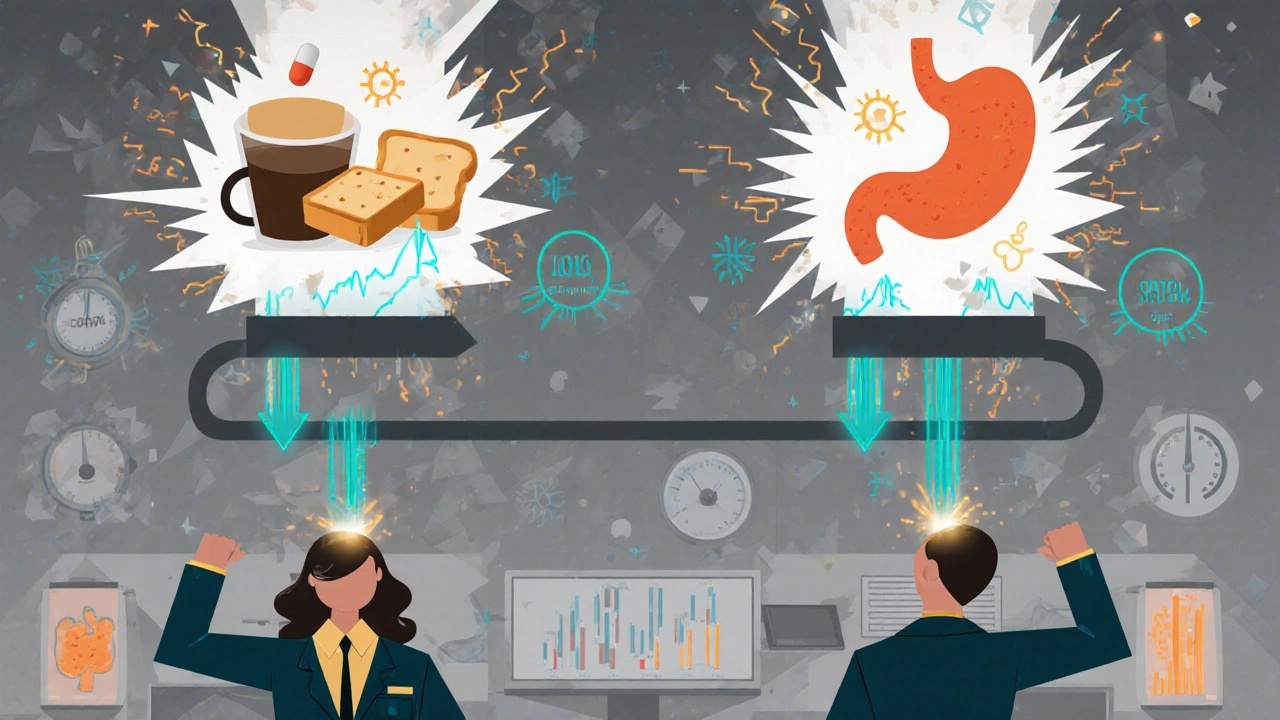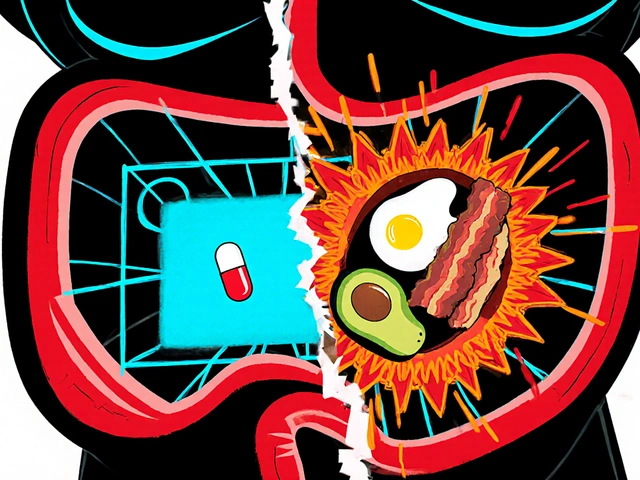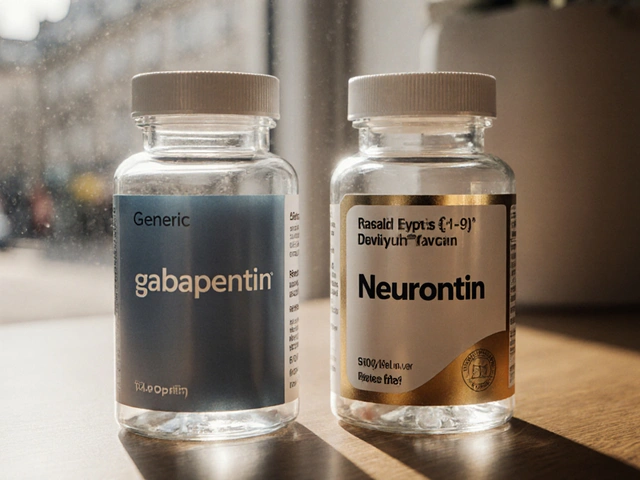When you take a pill, it doesn’t just disappear into your bloodstream. What you ate - or didn’t eat - before swallowing it can change everything. That’s the core idea behind fasted vs fed state testing, a standard practice in pharmaceutical development that’s just as critical for your health as the drug itself. It’s not about diet trends or fitness hacks. It’s about science: how your body handles medicine when your stomach is empty versus when it’s full.
Why the stomach matters more than you think
Most oral drugs don’t work the same way in a fasted state as they do in a fed state. That’s not a bug - it’s biology. When you eat, your stomach changes. Gastric emptying slows down. pH levels drop. Bile flows. Blood shifts toward digestion. These aren’t minor tweaks. They’re major switches that alter how drugs dissolve, move through your gut, and get absorbed. Take fenofibrate, a cholesterol-lowering drug. In a fed state, its bioavailability jumps by 200-300%. Take it on an empty stomach, and you might get less than half the benefit. Now consider griseofulvin, an antifungal. Food cuts its absorption by 50-70%. One drug needs food to work. The other works better without it. If regulators only tested one condition, doctors would be guessing - and patients could be underdosed or overdosed. The FDA and EMA now require dual-state testing for nearly all new oral drugs. Why? Because 35% of drugs show clinically meaningful food effects, according to a 2019 analysis of 1,200 New Drug Applications. That’s not rare. That’s the norm.What ‘fasted’ and ‘fed’ actually mean in a lab
Don’t assume you know what these terms mean. In pharmaceutical testing, they’re strictly defined. Fasted state means no food for at least 10 hours. Water is allowed. No coffee. No gum. No candy. This isn’t intermittent fasting for weight loss. This is a controlled, clinical condition designed to eliminate variables. Fed state isn’t just ‘after breakfast.’ It’s a standardized high-fat, high-calorie meal - about 800-1,000 calories, with 500-600 of those coming from fat. Think bacon, eggs, buttered toast, whole milk, avocado. The meal is carefully measured and served within 15 minutes. Participants must finish it. Then, the drug is given exactly 30 minutes later. Why this specific meal? Because fat slows gastric emptying and stimulates bile release - two of the biggest drivers of drug absorption changes. A banana and yogurt won’t cut it. A burger and fries? That’s the gold standard. Studies using SmartPill capsules show the difference is dramatic. In a fasted state, food stays in the stomach for about 14 minutes. In a fed state? Over 78 minutes. That’s more than five times longer. The pH drops from 2.5 to 1.5. Pressure in the stomach climbs from 30-304 mbar to consistently over 240 mbar. These aren’t subtle shifts. They’re physical barriers or highways for drugs.How this affects real-world dosing
Imagine a patient takes a blood pressure pill on an empty stomach because they were told to take it ‘first thing in the morning.’ But their usual routine includes coffee and toast before their dose. If the drug was only tested in a fasted state, the label might say ‘take on empty stomach’ - but the patient is getting inconsistent absorption. Their blood pressure could swing unpredictably. Or consider a cancer drug with a narrow therapeutic index. A 20% increase in absorption due to food could push the dose into toxic territory. A 20% drop could mean the treatment fails. That’s why the FDA requires fed-state testing for any drug where food changes bioavailability by more than 20% - especially for drugs like warfarin, cyclosporine, or certain HIV antivirals. Drug labels now reflect this. You’ll see warnings like: ‘Take with food’ or ‘Take on an empty stomach.’ Those aren’t random suggestions. They’re based on data from controlled fed and fasted trials. And if the label doesn’t say anything? That’s because the drug showed no significant food effect - which is rare.
It’s not just about drugs - the exercise connection
The same principles apply in exercise science. Fasted exercise - training after 8-12 hours without food - increases fat burning by 30-50% due to higher free fatty acid availability. Fed exercise - after a carb-rich meal - boosts glycogen use and endurance by up to 8.3% in longer workouts. But here’s the catch: what works for fat loss doesn’t always work for performance. A 2018 meta-analysis of 46 studies found fed-state exercise improved aerobic performance beyond 60 minutes, but showed no benefit for shorter sessions. Meanwhile, fasted training upregulated PGC-1α - a gene linked to mitochondrial growth - by 40-50%. That’s a signal your body is adapting to burn fuel more efficiently. Yet, some people feel dizzy or weak fasted. Others crash mid-workout. A 2022 Reddit survey of 1,247 people found 68% performed better fed. But in a keto-focused group, 42% preferred fasted. Why? Individual biology matters. Genetics, like variants in the PPARGC1A gene, explain up to 33% of how people respond. This isn’t about which is ‘better.’ It’s about context. For athletes needing peak output? Fed. For metabolic health in sedentary people? Fasted may help. But the key is consistency. You can’t switch back and forth randomly and expect reliable results.Why testing both is non-negotiable
The push for dual-state testing isn’t bureaucracy. It’s safety. In 2023, the FDA expanded requirements to include diverse ethnic populations because research showed Asian subjects empty their stomachs 18-22% slower than Caucasians in fed conditions. A drug that works fine in one group might be ineffective or dangerous in another. The European Medicines Agency now requires fed-state testing for any oral drug with unknown food effects. And they’re going further - in 2024, they started requiring continuous glucose monitoring during these trials to track real-time metabolic responses. The market reflects this. The global bioequivalence testing industry hit $2.7 billion in 2022, with dual-state protocols making up 65% of all studies. Why? Because companies can’t afford to launch a drug that fails in real life. If a patient takes it with food and it doesn’t work, they stop. If it causes side effects, they sue.
What you should know as a patient
You don’t need to run a clinical trial. But you do need to read the label. If your prescription says ‘take on an empty stomach,’ do it. Don’t take it with your morning coffee or toast. If it says ‘take with food,’ eat something - even a small snack. Don’t assume ‘with food’ means a full meal. A few crackers or a banana can make a difference. If you’re unsure, ask your pharmacist. They see these labels every day. They know which drugs are sensitive to food. And if you’re on multiple medications, timing matters. Some drugs need to be spaced apart from meals. Others need to be taken together. This isn’t about being perfect. It’s about being consistent. Your body responds to patterns. If you take your pill with food one day and on an empty stomach the next, you’re essentially taking two different doses. That’s how treatment fails - not because the drug is broken, but because the conditions changed.The future: personalization is coming
The next wave isn’t just fasted or fed. It’s personalized. Researchers are starting to map how genes, gut microbiome, and even circadian rhythms affect drug absorption. A 2022 study found genetic differences explain why some people absorb drugs better with food and others don’t. In the future, you might get a test - maybe a simple saliva swab - that tells you whether you’re a ‘fasted responder’ or a ‘fed responder’ for certain medications. Until then, the best advice is simple: follow the label. Don’t guess. Don’t assume. The science behind fasted vs fed state testing exists because real people got sick from inconsistent dosing. It’s not about diets. It’s about dosing. And that’s something no influencer, no trend, no ‘biohack’ can replace.What does ‘fasted state’ mean in drug testing?
In pharmaceutical testing, fasted state means no food for at least 10 hours before taking the drug. Only water is allowed. This ensures the stomach is empty and baseline conditions are consistent across all participants.
Why is a high-fat meal used in fed state testing?
A high-fat meal (800-1,000 calories, with 500-600 from fat) slows gastric emptying and triggers bile release - two key factors that affect how drugs are absorbed. This mimics the worst-case scenario for food-drug interactions, ensuring the drug is safe even under extreme conditions.
Can I skip the food requirement if I feel fine?
No. Even if you feel fine, skipping the food instruction can lead to underdosing or overdosing. Some drugs vary by 50-300% in absorption depending on food. What feels normal today could cause problems tomorrow.
Do all drugs need fed and fasted testing?
Not all, but most. The FDA and EMA require dual-state testing for oral drugs when food could affect absorption by more than 20%. About 35% of all oral drugs show clinically significant food effects, so it’s standard practice.
How does this affect my daily medication routine?
Always follow the label. If it says ‘take on an empty stomach,’ wait 1-2 hours after eating. If it says ‘take with food,’ have a small snack. Consistency matters more than perfection. Switching between conditions can lead to unstable drug levels in your blood.








Douglas cardoza November 23, 2025
I used to take my statin on an empty stomach because the label said so, but I kept getting stomach cramps. One day I tried it with a little peanut butter toast and boom - no more issues. Turns out my body just needed that fat to absorb it right. Never thought food could be that powerful with meds.
Now I always check with my pharmacist. They’re the real MVPs.
Adam Hainsfurther November 24, 2025
This is one of those topics that gets buried under wellness influencers screaming about ‘fasting for detox.’ The real science here is terrifyingly precise - and underappreciated.
The FDA’s requirement for high-fat meals in fed-state testing isn’t arbitrary. It’s designed to simulate the worst-case scenario for absorption variability. If a drug works under that condition, it’ll work under almost any real-world scenario. That’s risk mitigation at its finest.
And yet, most patients have no idea why their prescription says ‘take with food.’ It’s not a suggestion. It’s a pharmacokinetic safeguard.
Rachael Gallagher November 25, 2025
Big Pharma doesn’t want you to know this - they’d rather you take pills like candy and blame your body when it fails. But the truth? Food controls your drugs. Not you. Not your willpower. The system’s rigged to make you dependent, not informed.
steven patiño palacio November 25, 2025
Just wanted to clarify something that came up in the post: when a label says ‘take with food,’ it doesn’t mean you need a full meal. A small snack - even a few crackers or a banana - can be enough to trigger the physiological changes needed for proper absorption.
Many patients overthink this and skip doses because they ‘didn’t eat enough.’ That’s unnecessary. The goal is consistency, not perfection. A little food is better than none, especially for drugs with narrow therapeutic windows.
stephanie Hill November 26, 2025
Did you know the FDA started requiring fed-state testing after a bunch of people died in the 90s from overdosing because they took their meds with grapefruit juice? They didn’t tell you that, did they?
And now they’re pushing ‘personalized dosing’? That’s just the next step - selling you genetic tests so they can charge you more. The real solution? Stop letting corporations control your medicine.
They’re not protecting you. They’re protecting their profits.
Akash Chopda November 27, 2025
the system is designed to keep you confused so you keep buying pills and never question why you need them in the first place
Nikki C November 28, 2025
It’s wild how much our biology is shaped by meals we don’t even think about.
I used to take my thyroid med with coffee because I was in a rush. Turns out coffee slows absorption by like 55%. My TSH went through the roof. My endo didn’t even ask about my morning routine.
Now I take it with water, 30 minutes before anything else. Simple. But life-changing.
It’s not magic. It’s just physics and chemistry - and we treat it like folklore.
Alex Dubrovin November 29, 2025
fasted workout before my med? bad idea. i passed out on the treadmill once. now i eat a banana first. no more drama.
also why do labels say 'take with food' but never say what food? that's just lazy
Jacob McConaghy November 30, 2025
Love how this post ties drug science to exercise physiology. Same rules apply.
People argue about fasted vs fed training like it’s a moral choice. It’s not. It’s biochemistry. Your genes, your goals, your lifestyle - those decide what works.
Same with meds. Don’t copy someone else’s routine. Read your label. Talk to your pharmacist. Track how you feel. Small changes, big impact.
And yeah - if you’re on warfarin or cyclosporine? Don’t mess around. Your life isn’t a TikTok trend.
Natashia Luu December 1, 2025
It is truly alarming that the general public remains so woefully uninformed regarding the pharmacokinetic implications of dietary intake in relation to prescribed therapeutics. The negligence exhibited by healthcare providers in adequately counseling patients on these critical variables constitutes, in my estimation, a systemic failure of professional duty.
One cannot reasonably expect laypersons to intuit the biochemical consequences of ingesting a calcium-rich dairy product with a tetracycline derivative. This is not mere oversight - it is institutional complacency.
akhilesh jha December 2, 2025
in india we dont have this testing. my aunt takes her blood pressure med with chai. she says it tastes better. last month she had a stroke. the doctor said maybe the tea messed with the absorption. i dont know. nobody explains anything here.
they just give pills. and hope.